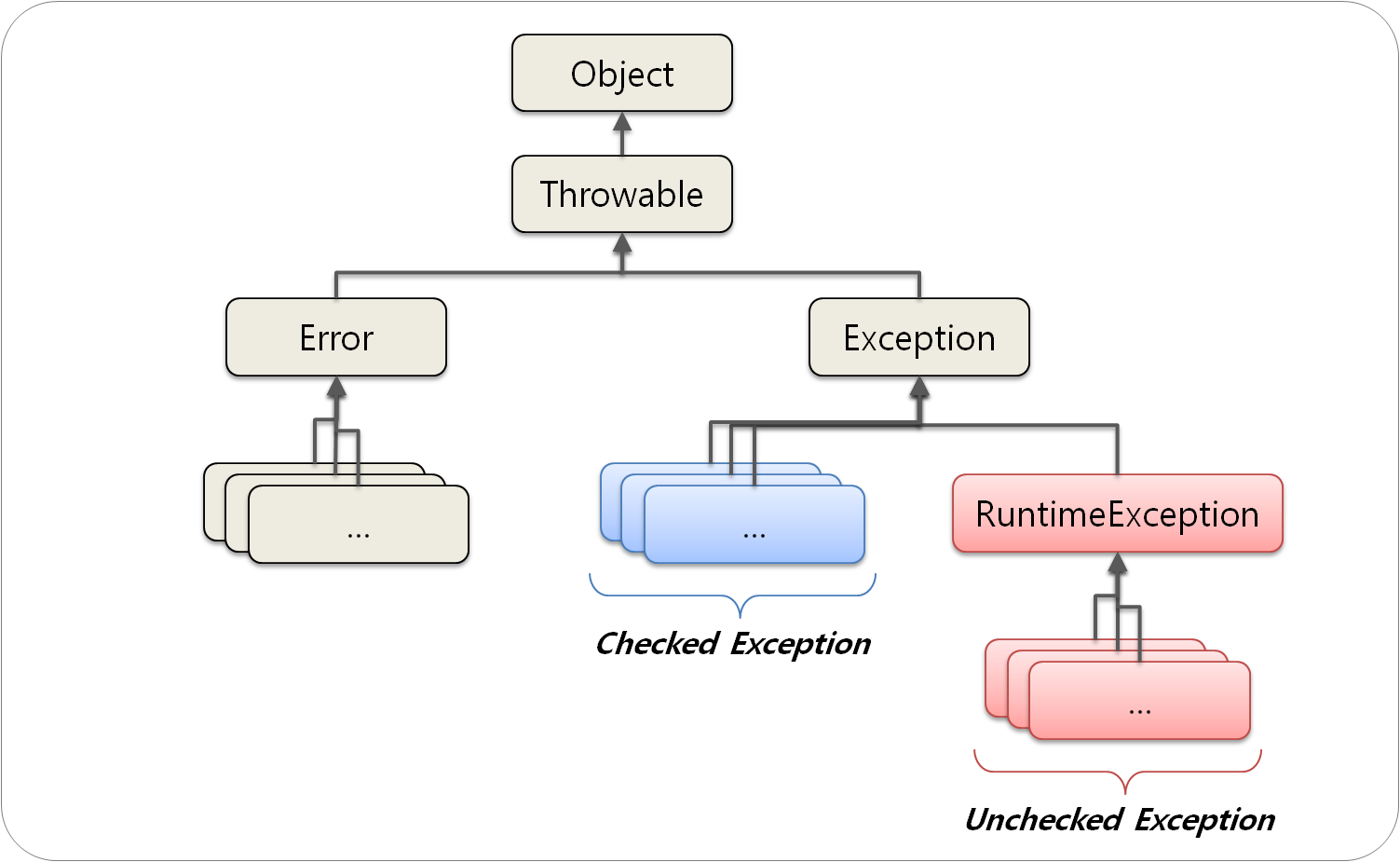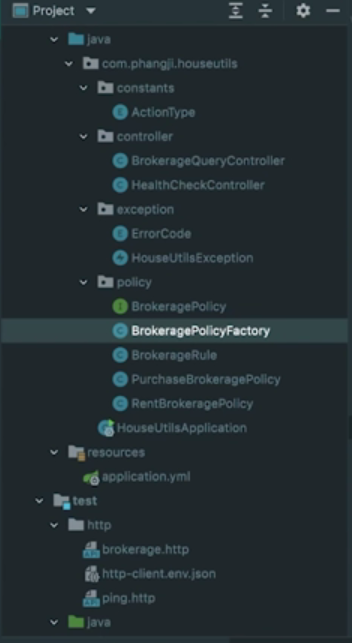1. 예외 처리 방식
- 오류 코드를 리턴하지 말고 예외를 던져라
- 현재는 예외를 던지는 것이 일반화 되었다. 처리 흐름이 깔끔하다.
예제 1. 좋은 예, try - catch로 예외처리
public class DeviceController {
// ...
public void sendShutDown() {
try {
tryToShutDown();
} catch (DeviceShutDownError e) {
logger.log(e);
}
}
private void tryToShutDown() throws DeviceShutDownError {
DeviceHandle handle = getHandle(DEV1);
DeviceRecord record = retrieveDeviceRecord(handle);
pauseDevice(handle);
clearDeviceWorkQueue(handle);
closeDevice(handle);
}
private DeviceHandle getHandle(DeviceId id) {
// ...
throw new DeviceShutDownError("Invalid handle for: " + id.toString());
// ...
}
// ...
}2. Unchecked Exception을 사용하라
1) Exception 가계도

- Exception을 상속하면 checked Exception.
- 명시적인 예외 처리가 필요하다.
- 예 : IOException, SQLException
- RuntimeException을 상속하면 UncheckedException.
- 명시적인 예외 처리가 필요하지 않다.
- 예 : NullPointerException, IllegalArgumentException, IndexOutOfBoundException
2) Effective Java - Exception에 관한 규약
- 자바 언어 명세가 요구하는 것은 아니지만, 업계에 널리 퍼진 규약으로 Error 클래스를 상속해 하위 클래스를 만드는 일은 자제하자.
- 즉, 사용자가 직접 구현하는 unchecked throwable은 모두 RuntimeException의 하위 클래스여야 한다.
- Exception, RuntimeException, Error를 상속하지 않는 throwable을 만들 수도 있지만, 이러한 throwable은 정상적인 사항보다 나을 게 하나도 없으면서 API 사용자를 헷갈리게 할 뿐이므로 절대로 사용하지 말자.
3) checked Exception이 나쁜 이유
- 특정 메소드에서 checked exception을 throw하고 상위 메소드에서 그 exception을 catch 한다면, 모든 중간단계 메소드에 exception을 throws해야한다.
- 이는 OCP(개방 폐쇄 원칙)위배이다. 상위 메소드에서 하위 레벨 메소드의 디테일에 대해 알아야하기 때문이다.
- 필요한 경우 checked exception을 사용해야 되지만, 일반적인 경우 득보다 실이 많다.
- 파이썬, C#, C++, 루비는 checked exception을 지원하지 않음에도 안정적인 소프트웨어를 구현하기에 무리가 없다.
3. Exception 잘 쓰기
1) 예외에 메시지를 담아라
- 예제 1의
throw new DeviceShutDownError("Invalid handle for: " + id.toString());처럼 사용한다. - 오류가 발생한 원인과 위치를 찾기 쉽도록, 예외를 던질 때는 전후 상황을 충분히 덧붙인다.
- 실패한 연산 이름과 유형 등 정보를 담아 예외를 던진다.
2) exception wrapper
예외를 감싸는 클래스를 만든다
- port.open() 시 발생하는 checked exception들을 감싸도록 port를 가지는 LocalPort 클래스를 만든다.
- port.open()이 던지는 checked 들을 하나의 PortDeviceFailure exception으로 감싸서 던진다.
예제 2. 나쁜 예
- 로그로 찍을 뿐 할 수 있는 일이 없다.
ACMEPort port = new ACMEPort(12);
try {
port.open();
} catch (DeviceResponseException e) {
reportPortError(e);
logger.log("Device response exception", e);
} catch (ATM1212UnlockedException e) {
reportPortError(e);
logger.log("Unlock exception", e);
} catch (GMXError e) {
reportPortError(e);
logger.log("Device response exception", e);
}예제 3. 좋은 예
LocalPort port = new LocalPort(12);
try {
port.open();
} catch (PortDeviceFailure e) {
reportError(e);
logger.log(e.getMessage(), e);
} finally {
...
}
public class LocalPort {
private ACMEPort innerPort;
public LocalPort(int portNumber) {
innerPort = new ACMEPort(portNumber);
}
public void open() {
try {
innerPort.open();
} catch (DeviceResponseException e) {
throw new PortDeviceFailure(e);
} catch (ATM1212UnlockedException e) {
throw new PortDeviceFailure(e);
} catch (GMXError e) {
throw new PortDeviceFailure(e);
}
}
// ..
}4. 실무 예외 처리 패턴
1) getOrElse
- 예외 대신 기본 값을 리턴한다.
- null이 아닌 기본 값
- 도메인에 맞는 기본 값
(1) null이 아닌 기본 값 예제
예제 4. 나쁜 예
List<Employee> employees = getEmployees();
if (employee != null) {
for(Employee e : employees) {
totalPay += e.getPay();
}
}- null을 리턴한다면, 이후 코드에서도 모두 null 체크가 있어야 한다.
예제 5. 좋은 예
List<Employee> employees = getEmployees();
for(Employee e : employees) {
totalPay += e.getPay();
}
public List<Employee> getEmployees() {
if ( /*.. 직원이 없을 경우 .. */)
return Collections.emptyList();
}
}- 복수 형의 데이터를 가져올 떄는 데이터가 없음을 의미하는 컬렉션을 리턴하면 된다.
- null 보다 size가 0인 컬렉션이 훨씬 안전하다.
- 빈 컬렉션이 for문에 들어가면 안전하게 종료된다.
(2) 도메인에 맞는 기본 값 예제
예제 6. 나쁜 예
UserLevel userLevel = null;
try {
User user = user.Repository.findByUserId(userId);
userLevel = user.getUserLevel();
} catch (UserNotfoundException e) {
userLevel = UserLevel.BASIC;
}- 호출부에서 예외 처리를 통해 userLevel 값을 처리한다.
- 코드를 계속 읽어나가면서 논리적인 흐름이 끊긴다.
예제 7. 좋은 예
- 호출부 - 단순해짐
UserLevel userLevel = userService.getuserLevelOrDefault(userId);- UserService 클래스
public class UserService {
public static final UserLevel USER_BASIC_LEVEL = UsrLevel.BASIC;
public UserLevel getUserLevelOrdefault(Long userId) {
try {
User user = userRepository.findByUserId(userId);
return user.getUserLevel();
} catch(UserNotFoundException e) {
return USER_BASIC_LEVEL;
}
}
}- 예외 처리를 데이터를 제공하는 쪽에서 처리해 호출부 코드가 심플해진다.
- 코드를 읽어가며 논리적인 흐름이 끊기지 않는다.
- 도메인에 맞는 기본 값을 도메인 서비스에서 관리한다.
2) getOrElseThrow
(1) (기본 값이 없다면) null 대신 예외를 던진다.
예제 8. 나쁜 예
User user = userRepository.findByUseId(userId);
if (user != null) {
// user를 이용한 처리
}- user를 사용하는 쪽에서 매번 체크를 해야한다.
- 가독성 뿐만 아니라 안정성도 떨어진다.
- null 체크가 빠진 부분이 발생할 수 있다.
예제 9. 좋은 예
- 호출부
User user = user.Service.getUserOrElseThrow(userId);- UserService 클래스
public class UserService {
public static final UserLevel USER_BASIC_LEVEL = UsrLevel.BASIC;
public User getUserOrElseThrow(Long userId) {
User user = userRepository.findByUserId(userId);
if (user == null) {
throw new IllegalArgumentException("User is not found. userId = " + userId)
}
return user;
}
}
}- 데이터를 제공하는 쪽에서 null 체크를 하여, 데이터가 없는 경우엔 예외를 던진다.
- 호출부에서 매번 null 체크를 할 필요 없이 안전하게 데이터를 사용할 수 있다.
- 호출부의 가독성이 올라간다.
(2) 파라미터의 null을 점검하라
예제 10. 나쁜 예
public class MetricsCalculator {
public double xProjection(Point p1, Point p2) {
return (p2.x - p1.x) * 1.5;
}
}
// calculator.xProjection(null, new Point(12, 13));
// NullPointerException 발생- null을 리턴하는 것도 나쁘지만 null을 메서드로 넘기는 것은 더 나쁘다.
- null을 메서드의 파라미터로 넣어야 하는 API를 사용하는 경우가 아니면 null을 메서드로 넘기지 마라.
예제 11. 좋은 예 - throw new ~ 사용
public class MetricsCalculator {
public double xProjection(Point p1, Point p2) {
if (p1 == null || p2 == null) {
throw InvalidArgumentException("Invalid argument for MetricsCalculator.xProjection");
}
return (p2.x - p1.x) * 1.5;
}
}- null이 들어오면 unchecked exception을 발생시킨다.
- 실무에서는 assert보다 예외를 던지는 방법을 훨씬 많이 사용한다.
예제 12. 좋은 예 - assert 사용
public class MetricsCalculator {
public double xProjection(Point p1, Point p2) {
assert p1 != null : "p1 should not be null";
assert p2 != null : "p2 should not be null";
return (p2.x - p1.x) * 1.5;
}
}실무에서는 보통 자신의 예외를 정의한다.
예제 13
public class MyProjectException extends RuntimeException {
private MyErrorCode errorCode;
private String errorMessage;
public MyProjectException(MyErrorCode errorCode) {
//
}
public MyProjectException(MyErrorCode errorCode, String errorMessage) {
//
}
}
public enum MyErrorCode {
private String defaultErrorMessage;
INVALID_REQUEST("잘못된 요청입니다."),
DUPLICATED_REQUEST("기존 요청과 중복되어 처리할 수 없습니다."),
// ...
INTERNAL_SERVER_ERROR("처리 중 에러가 발생했습니다.");
}
//호출부
if (request.getUserName() == null) {
throw new MyProjectException(ErrorCode.INVALID_REQUEST, "userName is null");
}- 장점
- 에러 로그에서 stacktrace 해봤을 때 우리가 발생시킨 예외라는 것을 바로 인지할 수 있다.
- 다른 라이브러리에서 발생한 에러와 섞이지 않는다. 우리도 IllegalArgumentException을 던지는 것보다 우리 예외로 던지는게 어느 부분에서 에러가 났는지 파악하기에 용이하다.
- 우리 시스템에서 발생한 에러의 종류를 나열할 수 있다.
6. 실습 강의에서 배운 것
예외 정의하기 전
- BrokeragePolicyFactory.java
public class BrokeragePolicyFactory {
public static BrokeragePolicy of(ActionType actionType) {
switch (actionType) {
case RENT:
return new RentBrokeragePolicy();
case PURCHASE:
return new PurchaseBrokeragePolicy();
default:
throw new IllegalArgumentException("해당 actionType에 대한 정책이 존재하지 않습니다.");
}
}
}예외 정의한 후
- BrokeragePolicyFactory.java
public class BrokeragePolicyFactory {
public static BrokeragePolicy of(ActionType actionType) {
switch (actionType) {
case RENT:
return new RentBrokeragePolicy();
case PURCHASE:
return new PurchaseBrokeragePolicy();
default:
throw new HouseUtilsExceptionException(ErrorCode.INVALID_REQUEST, "해당 actionType에 대한 정책이 존재하지 않습니다.");
}
}
}- HouseUtilsException
public classs HouseUtilsException extends RuntimeException {
private ErrorCode errorCode;
private String message;
public HouseUtilsException(ErrorCode errorCode) {
this(errorCode, errorCode.getMessage());
}
public HouseUtilsException(ErrorCode errorCode, String customMessage) {
super(customMessage);
this.errorCode = errorCode;
this.message = customMessage;
}
}- ErrorCode.java
@AllArgsContrustor
// getMessage를 없애고 여기에 @Getter(롬북의 일종)를 붙여도 된다.
public enum ErrorCode {
INVALID_REQUEST("잘못된 요청입니다.");
INTERNAL_ERROR("알 수 없는 에러가 발생했습니다.");
ENTITY_NOT_FOUND("데이터를 찾을 수 없습니다.");
private String message;
private String getMessage() {
return this.message();
}
}폴더 구조



내용 너무 좋아요!